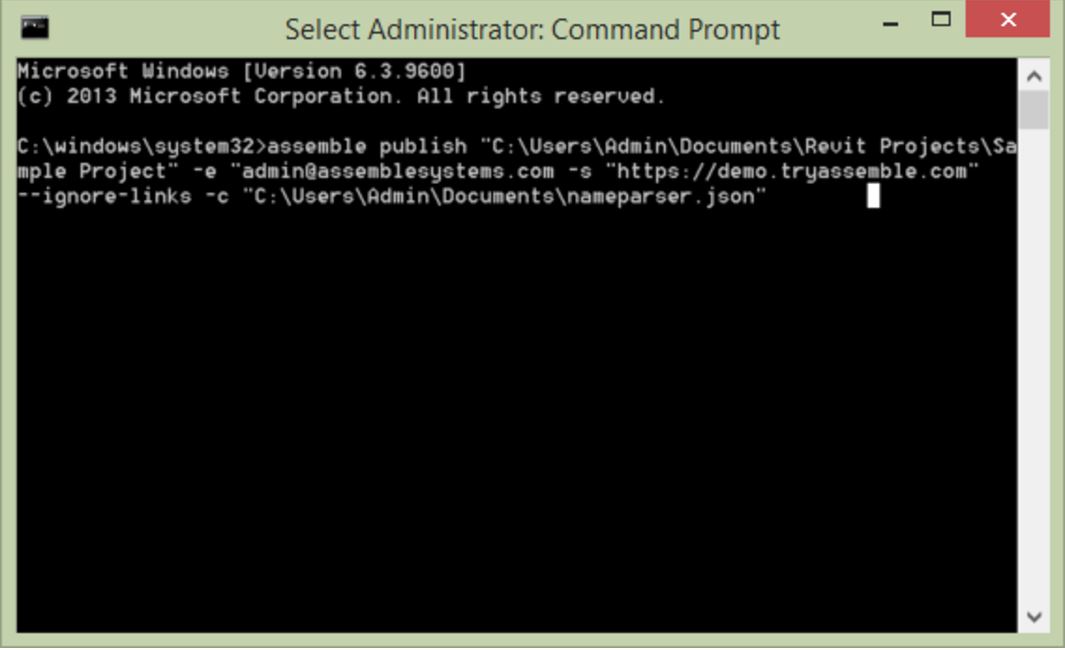Automated Publish Utility for Revit
With Assemble’s automated publish utility for Revit, users can publish a group of models using the Windows command line interface. This saves time when publishing several models on a routine basis. With this utility, you can set up a routine script or batch file to run against a set of projects, models, or model versions.
To publish your set of Revit models
The automated publish utility uses the name of its folder as the Project name. Organize models into folders with the project names. Subfolders are included in the publishing process.
Open the Command prompt and type the following command, substituting your username in the "name@" portion:
assemble publish "c:\YOUR MODEL FOLDER LOCATION" -s "http://demo.tryassemble.com/" -e "name@assemblesystems.com"
After this command, you are prompted to enter your password. Once you enter your password, the command launches Revit and publishes each model within the selected folder, including any models in subfolders.
Additional options include ignoring links (--ignore-links) and configuring the model name and version name (-c "c:\CONFIG FILE PATH\filename.json").
Note: When running this command, the publisher steps through each Revit file and opens the appropriate version (Revit 2017-2020 supported). If you do not have the associated version of Revit installed, the model is skipped. If links are not ignored, the process starts with the model that contains the most links.
Required Variables
Publish Directory: “C:\Users\Admin\Documents\BatchPubFolder” Provide the directory path, within quotes. Any Revit files within the directory will be processed.
Site Name: Provide your site name in quotes preceded by “-s” or “--site”:
-s or --site "https://demo.tryassemble.com"Optional Variables
Ignore Links: -i or --ignore-links
Publish Sheets: -a or --all-sheets
Configure Model and Version Naming: -c “C:\Users\Admin\Documents\ModelNameConfig.json” Provide file path to JSON config file. See Configuration File below.
Project Name
To allow for flexibility, the project name is the name of the folder it's in. This means that you can publish models for multiple projects within the same batch process. If you specify a folder that contains three subfolders (Project A, Project B, and Project C) each containing Revit models, you are publishing to Project A, Project B, and Project C within Assemble. If the project does not exist within Assemble, a new project is created.
Model Name
By default, the model name is the same as the Revit file name. If the model exists within the selected project, a new version is created. If not, a new model is created. If you specify a configuration file, you can use a substring of the file name. See Configuration File below. An example would be to split “Architecture_revision5.rvt” into the model name “Architecture” as defined in the configuration file.
Version Name
By default, the version name will be the timestamp generated when the publish begins. If you specify a configuration file, you can use a substring of the file name. In the same example as above, “Architecture_revision5.rvt” can result in the version name “revision5” as defined in the configuration file.
Configuration File
We are currently using a regular expression (or regex) stored in a JSON file to allow you to parse a model name and version name from Revit. Below is an example of using a regular expression to parse the Revit file name for the model and version:
Models:
Some_Model_XYZ_Rev0.5.rvt
Some_Model_XYZ_Rev0.8.rvt
Regular Expression (JSON):
{
"modelNameExpression": "((?<name>.+)_rev(?<version>.+)\\.rvt)|(?<name>.+)\\.rvt)"
}Results
Model: Some_Model_XYZ Version: 0.5 and 0.8
Model: Some_Model_ABC Version: 1
In this situation, “modelNameExpression” is the Revit file name and (?
If additional customization assistance is required, please contact https://knowledge.autodesk.com/contact-support.
